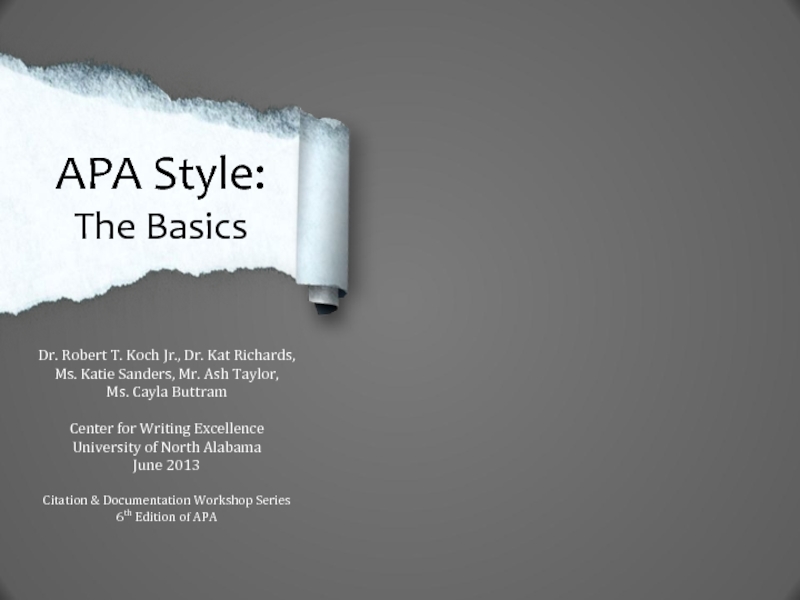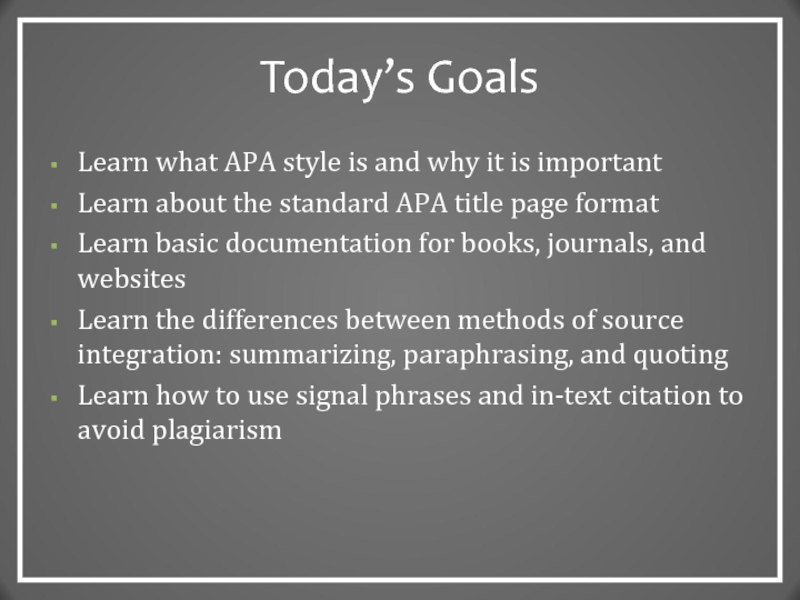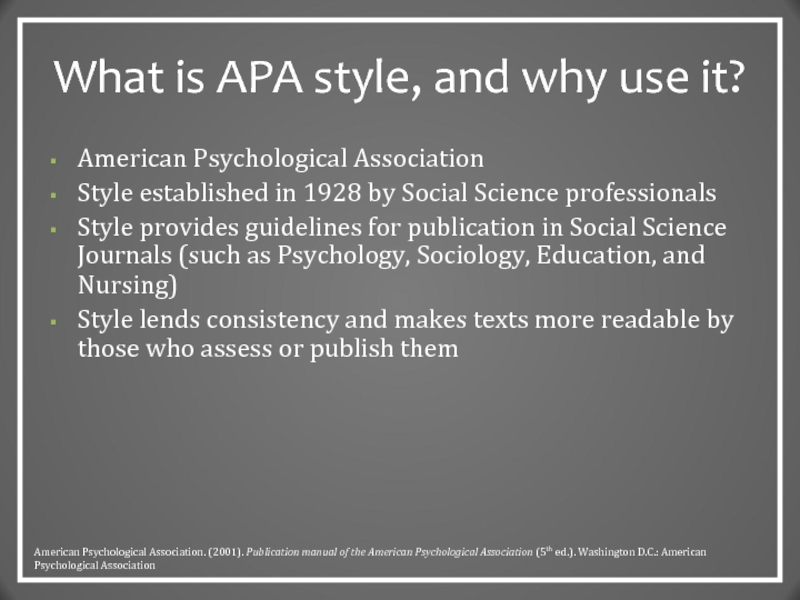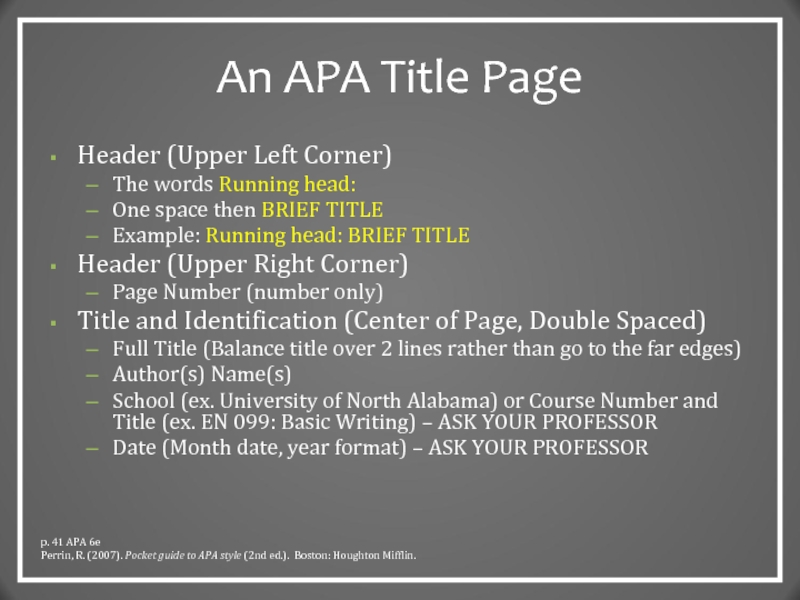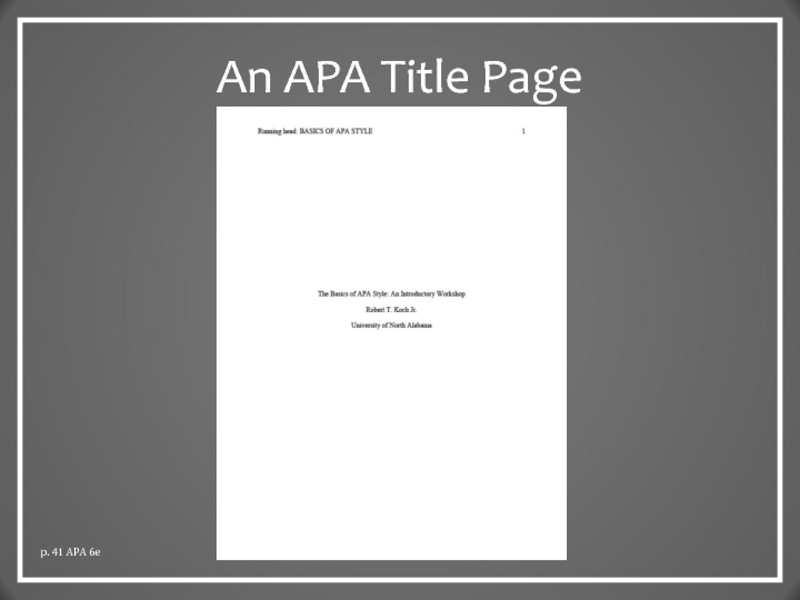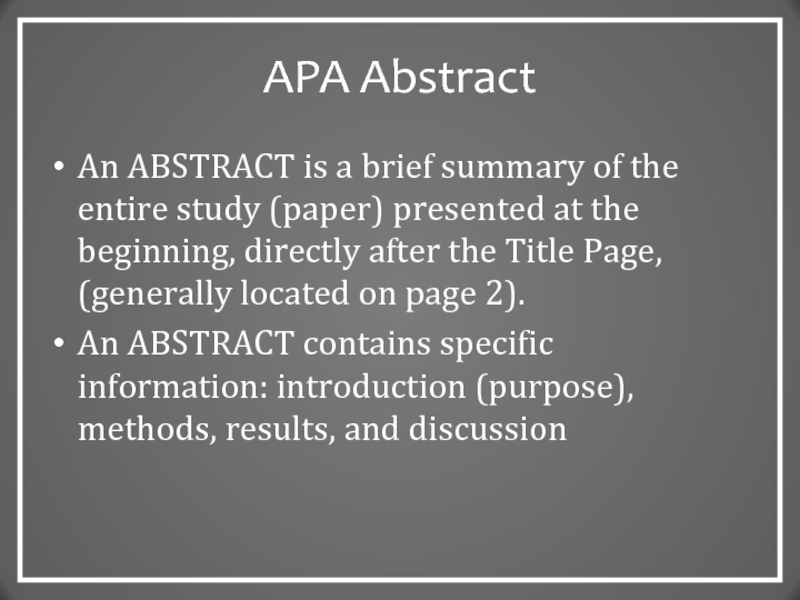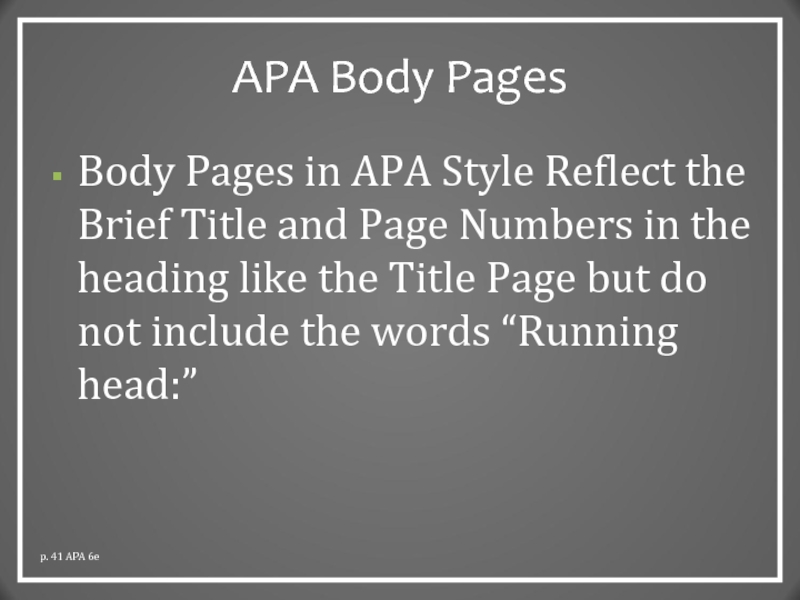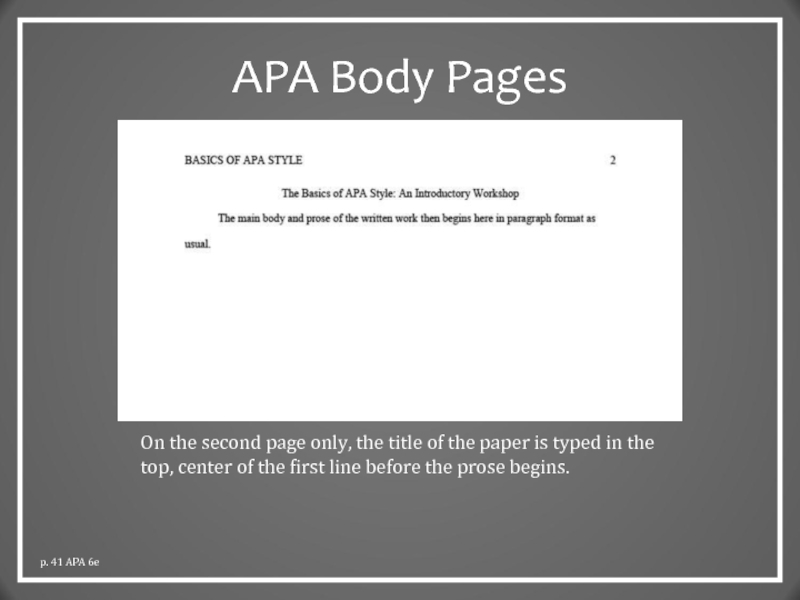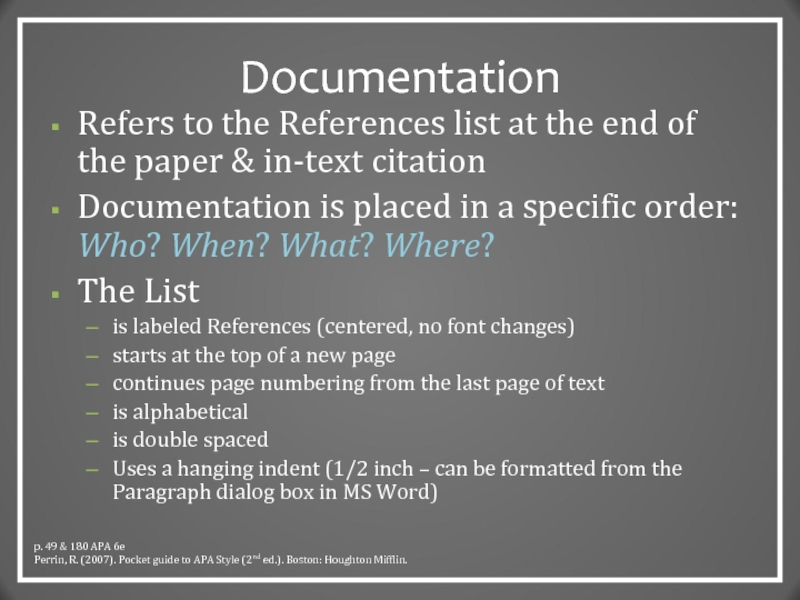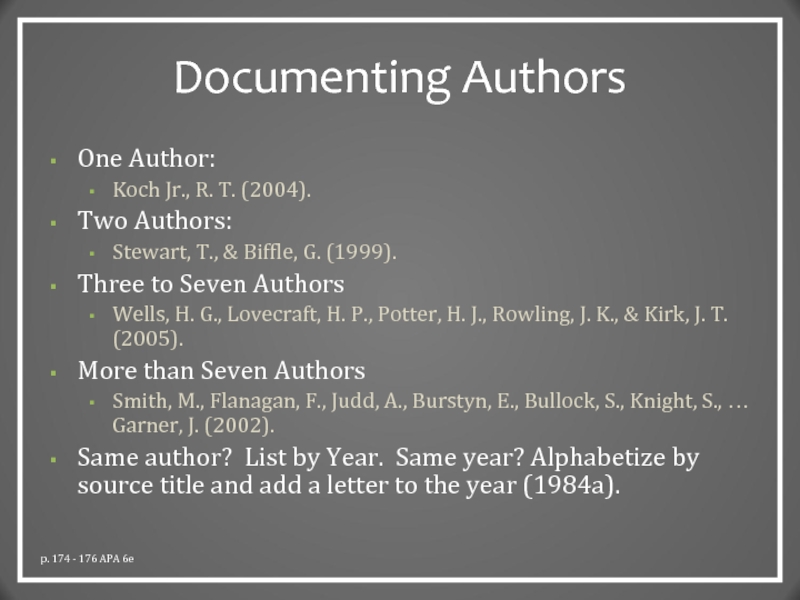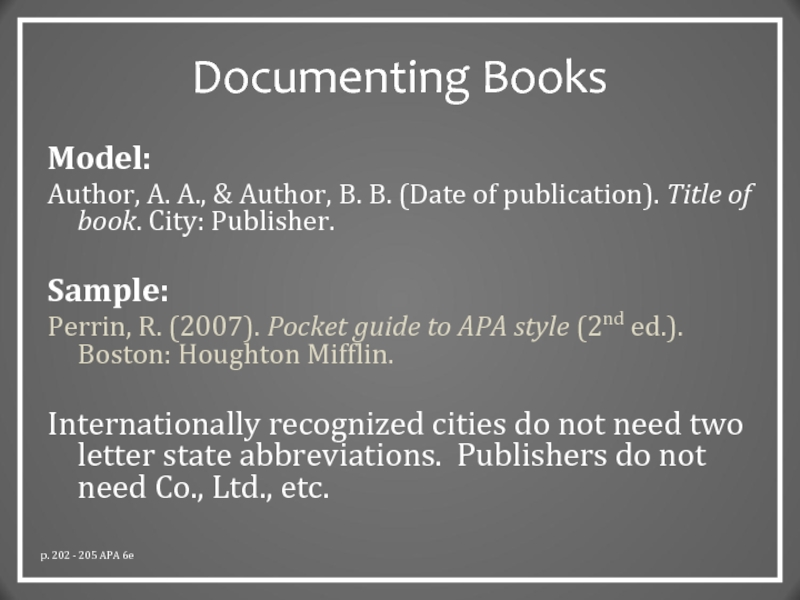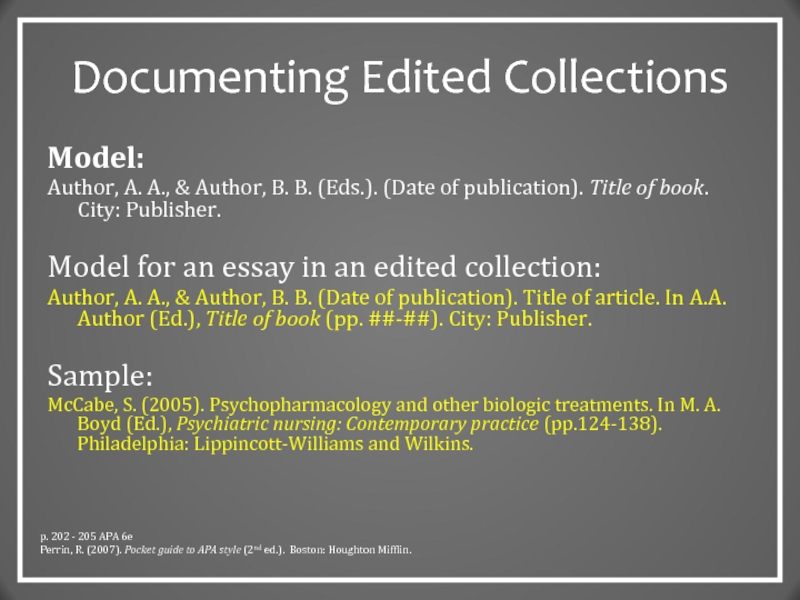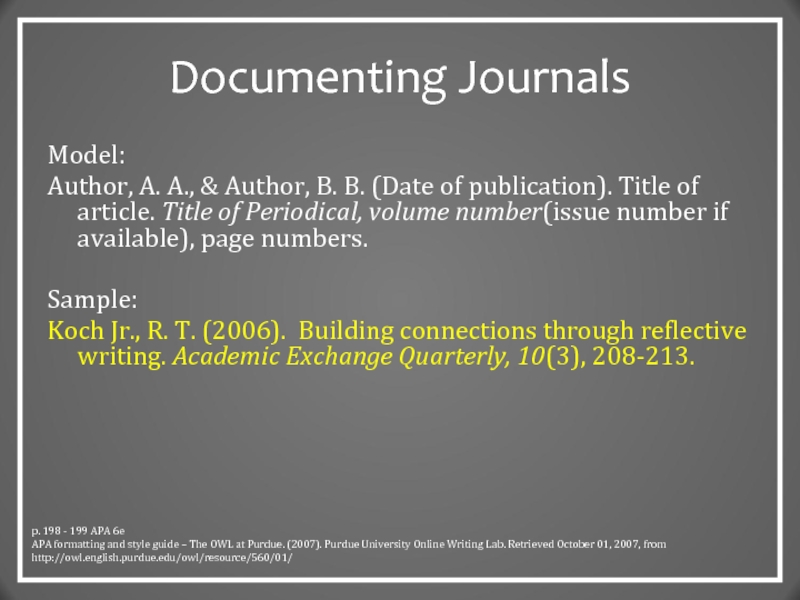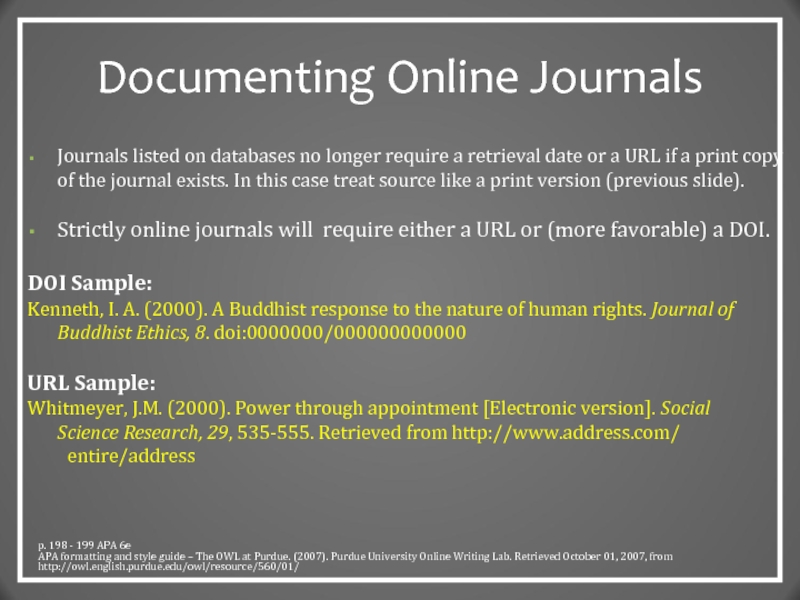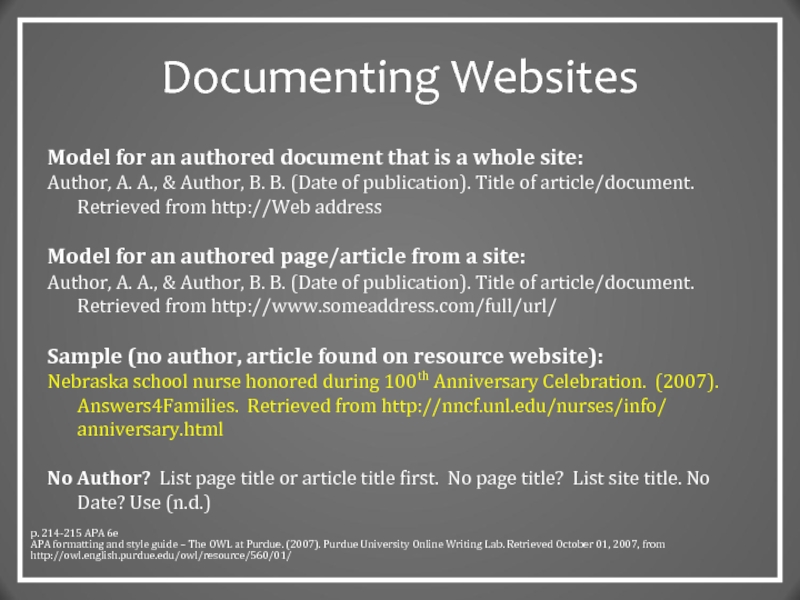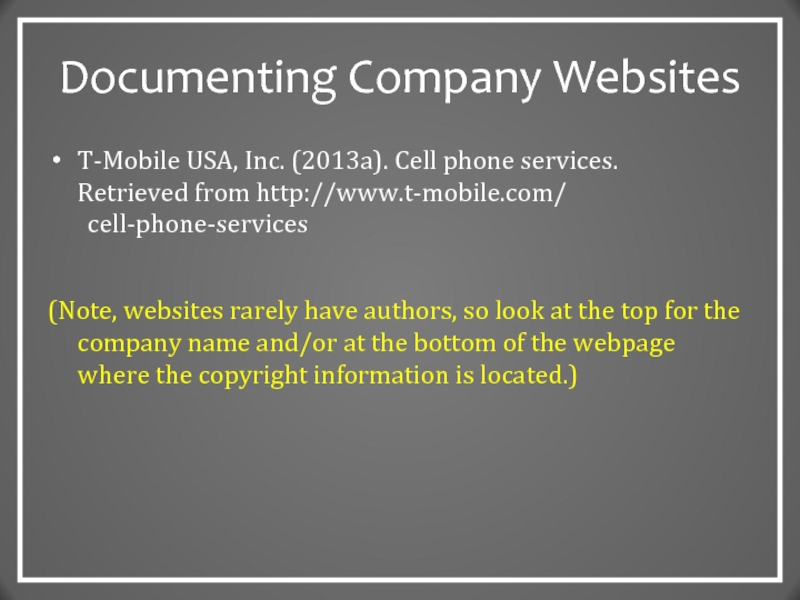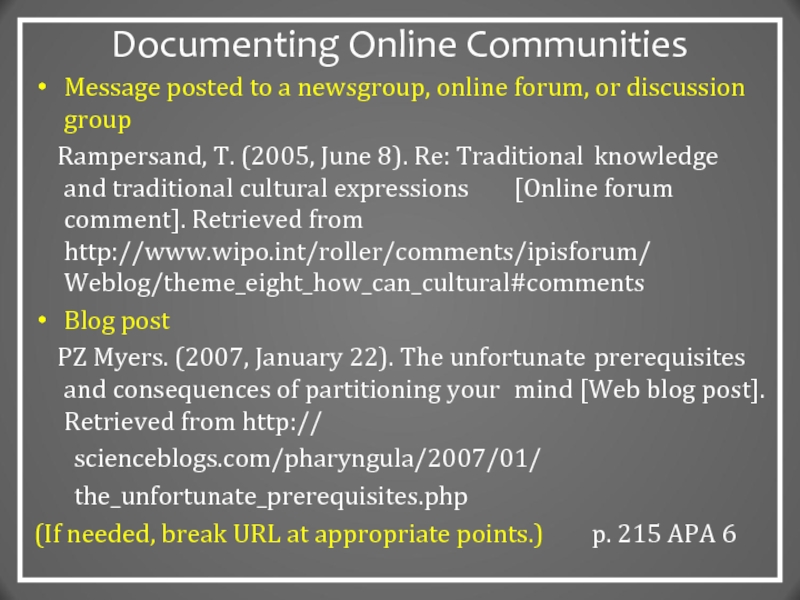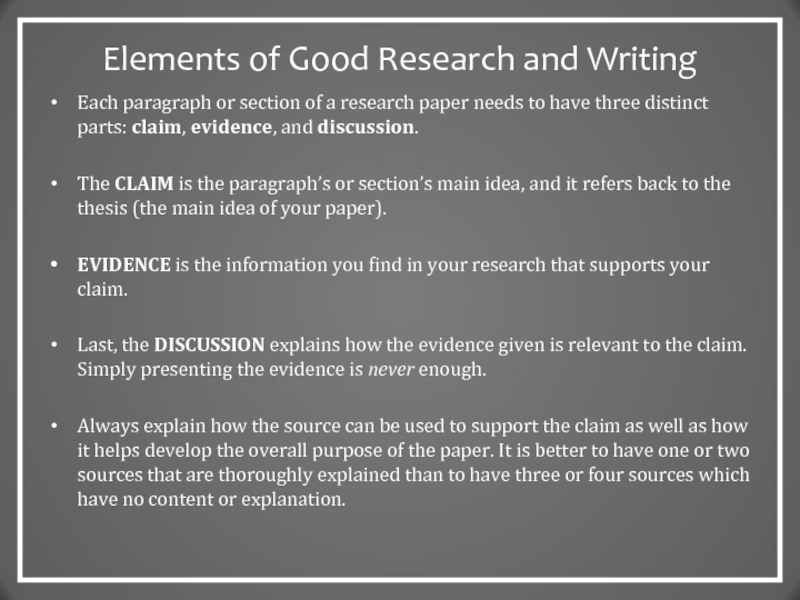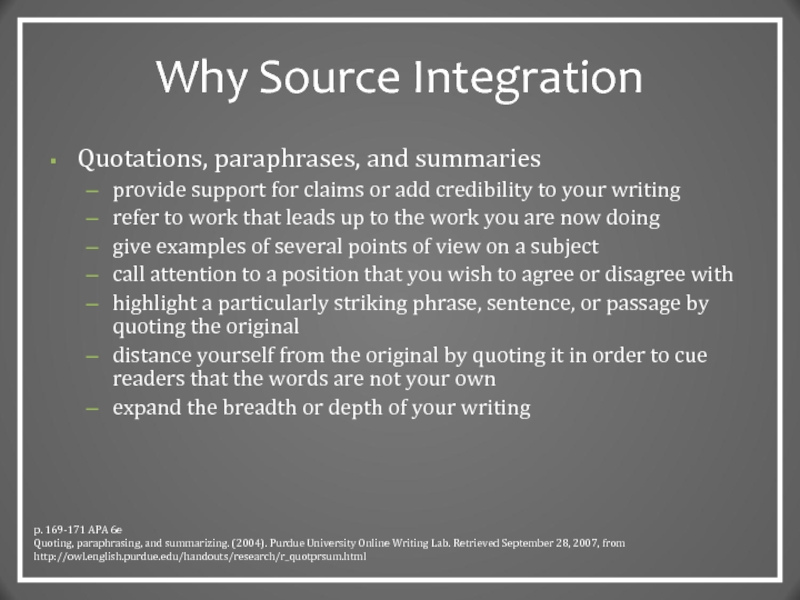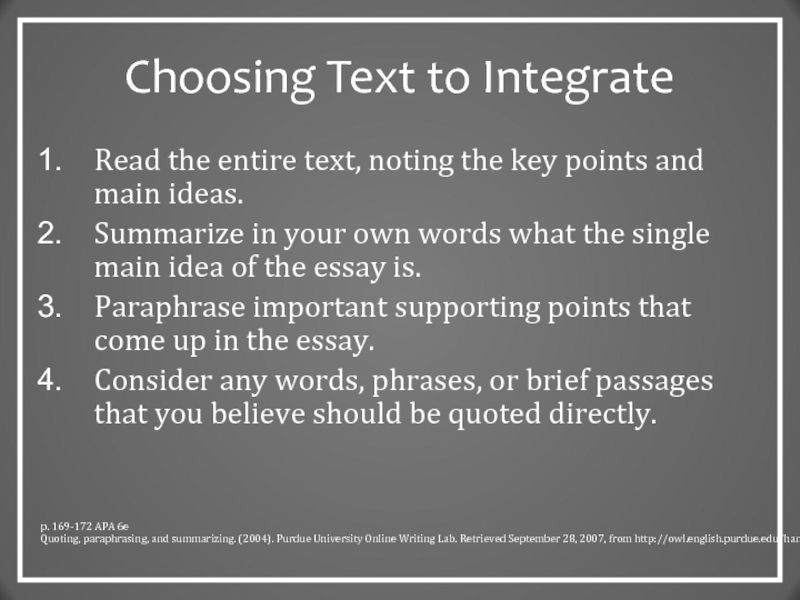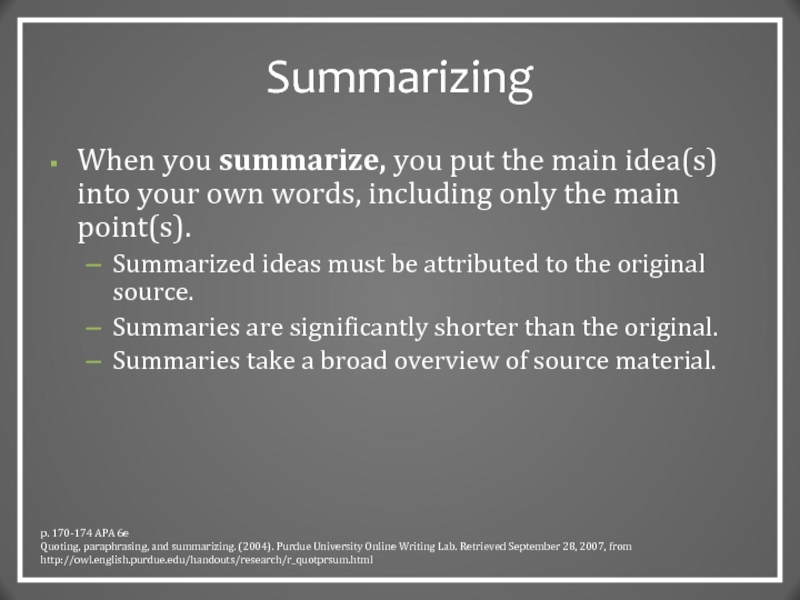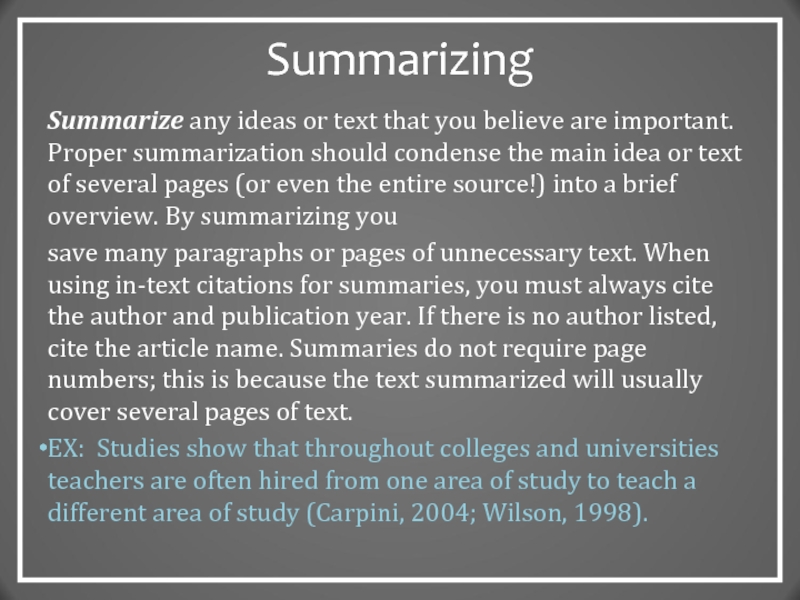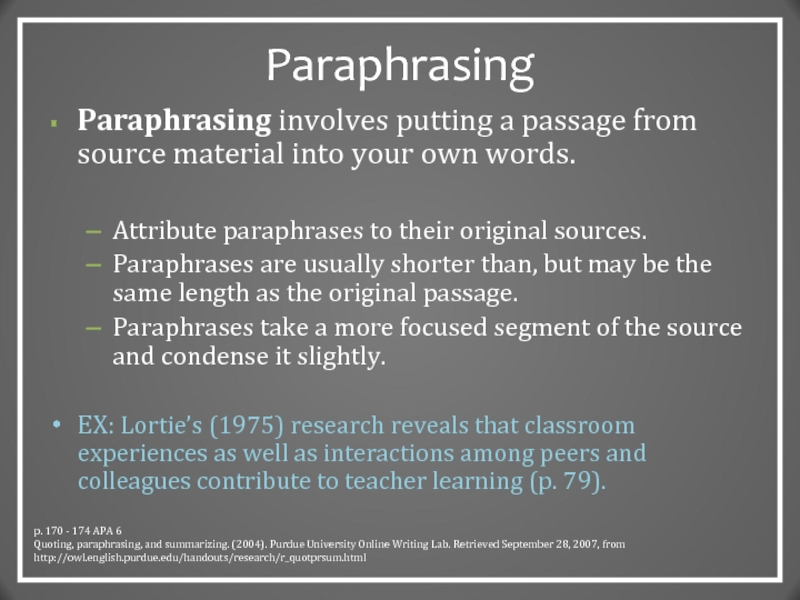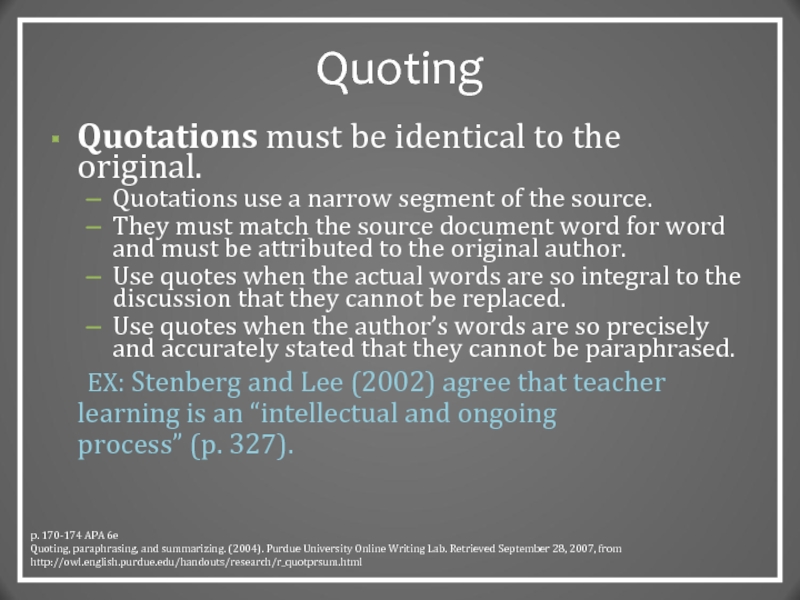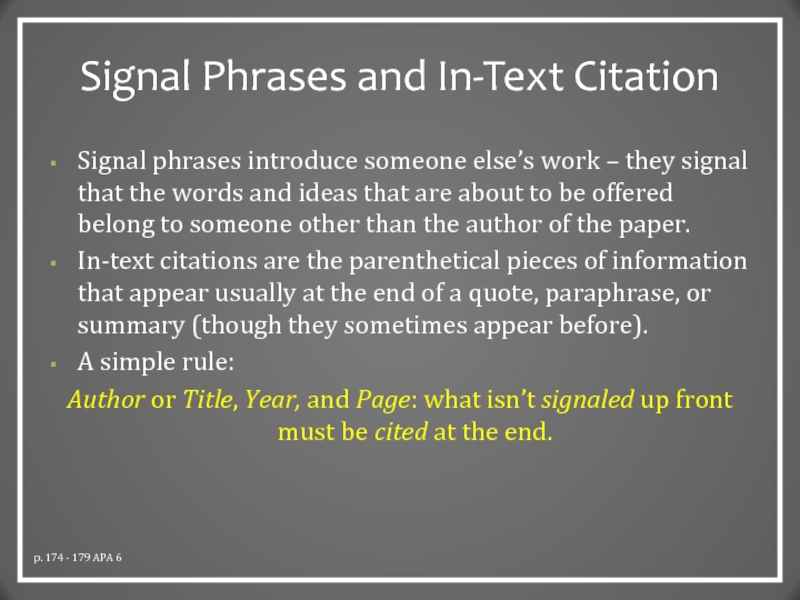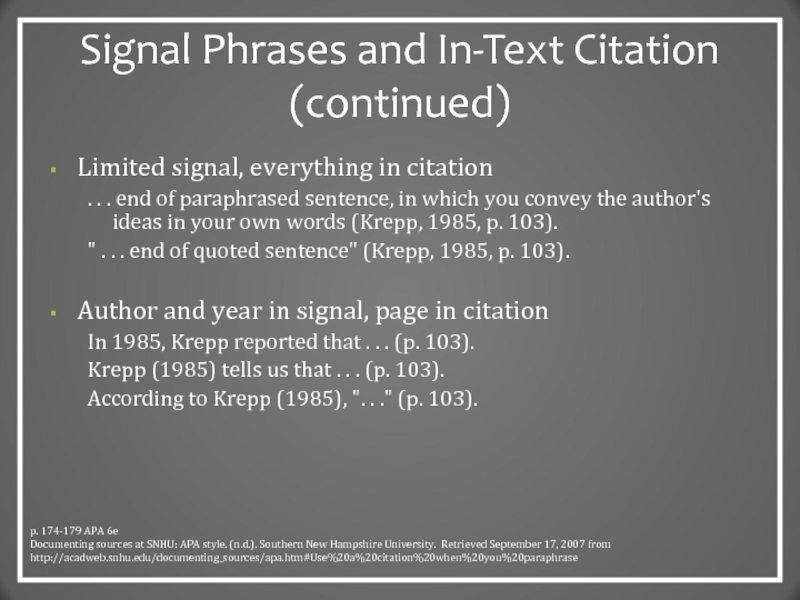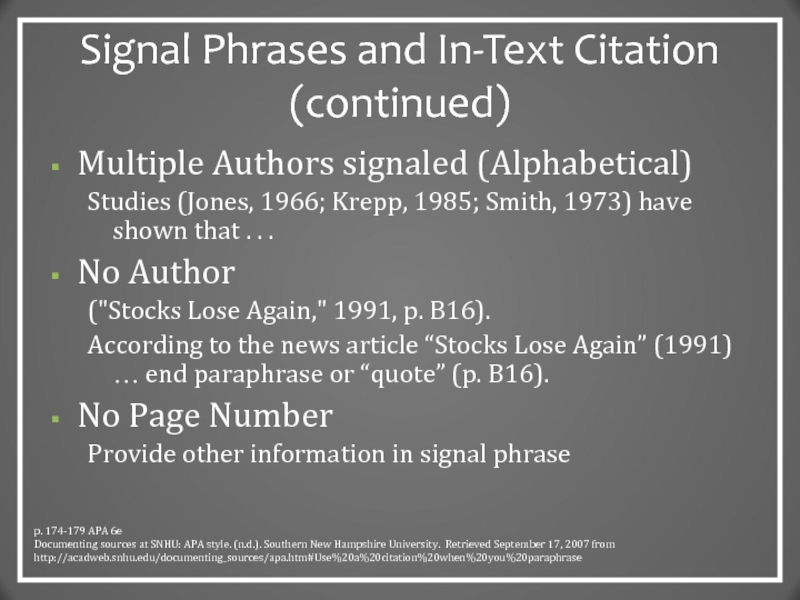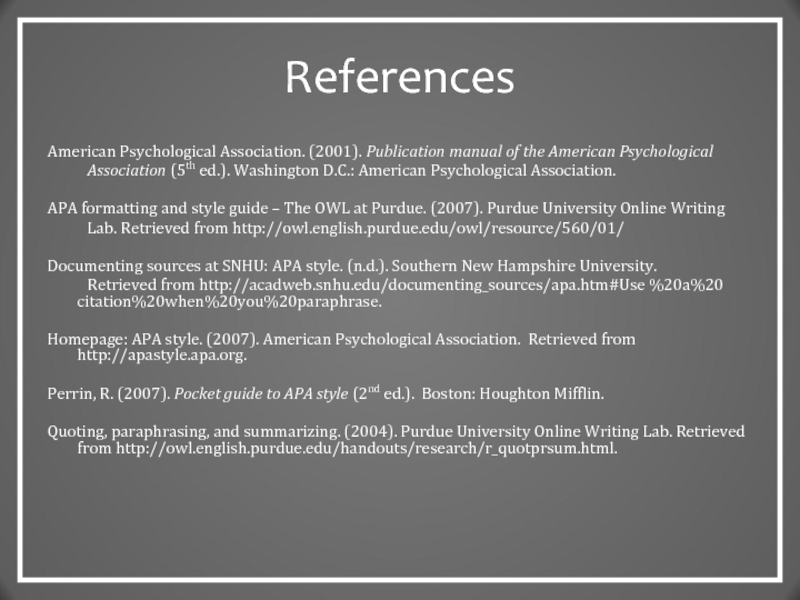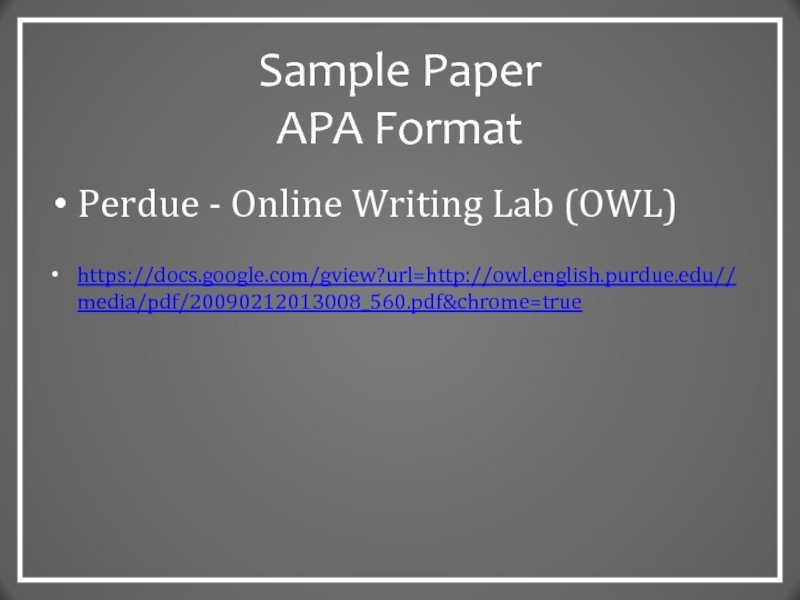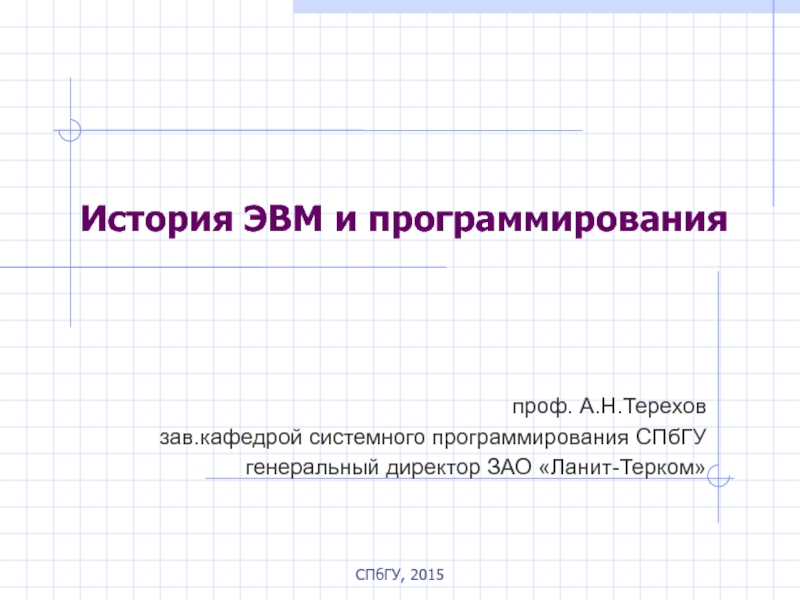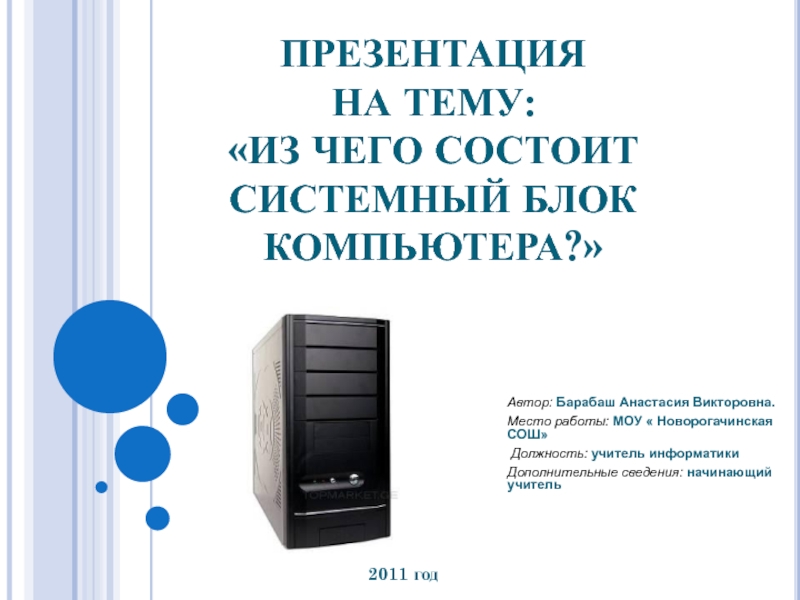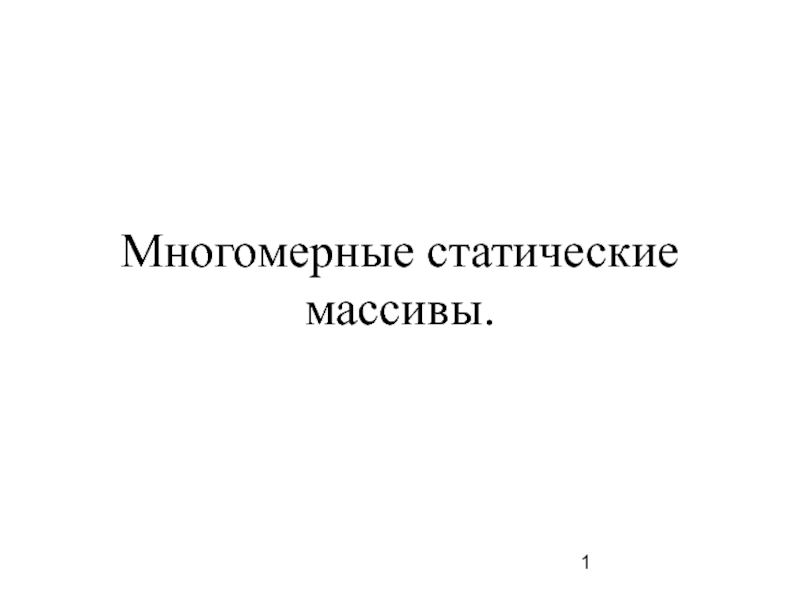- Главная
- Разное
- Дизайн
- Бизнес и предпринимательство
- Аналитика
- Образование
- Развлечения
- Красота и здоровье
- Финансы
- Государство
- Путешествия
- Спорт
- Недвижимость
- Армия
- Графика
- Культурология
- Еда и кулинария
- Лингвистика
- Английский язык
- Астрономия
- Алгебра
- Биология
- География
- Детские презентации
- Информатика
- История
- Литература
- Маркетинг
- Математика
- Медицина
- Менеджмент
- Музыка
- МХК
- Немецкий язык
- ОБЖ
- Обществознание
- Окружающий мир
- Педагогика
- Русский язык
- Технология
- Физика
- Философия
- Химия
- Шаблоны, картинки для презентаций
- Экология
- Экономика
- Юриспруденция
APA Style: The Basics презентация
Содержание
- 1. APA Style: The Basics
- 2. Today’s Goals Learn what APA style
- 3. What is APA style, and why
- 4. An APA Title Page Header (Upper
- 5. An APA Title Page p. 41 APA 6e
- 6. APA Abstract An ABSTRACT is a brief
- 7. APA Body Pages Body Pages in
- 8. APA Body Pages On the second
- 9. Documentation Refers to the References list
- 10. Documenting Authors One Author: Koch
- 11. Documenting Books Model: Author, A. A.,
- 12. Documenting Edited Collections Model: Author, A.
- 13. Documenting Journals Model: Author, A. A.,
- 14. Documenting Online Journals Journals listed on
- 15. Documenting Websites Model for an authored
- 16. Documenting Company Websites T-Mobile USA, Inc. (2013a).
- 17. Documenting Online Communities Message posted to a
- 18. More Online Documentation Online Magazine Article
- 19. Elements of Good Research and Writing
- 20. Why Source Integration Quotations, paraphrases,
- 21. Choosing Text to Integrate Read the
- 22. Summarizing When you summarize, you put
- 23. Summarizing Summarize any ideas or text that
- 24. Paraphrasing Paraphrasing involves putting a passage
- 25. Quoting Quotations must be identical to
- 26. Signal Phrases and In-Text Citation Signal
- 27. Signal Phrases and In-Text Citation (continued)
- 28. Signal Phrases and In-Text Citation (continued)
- 29. References American Psychological Association. (2001).
- 30. Sample Paper APA Format Perdue -
Слайд 1APA Style:
The Basics
Dr. Robert T. Koch Jr., Dr. Kat Richards,
Ms. Cayla Buttram
Center for Writing Excellence
University of North Alabama
June 2013
Citation & Documentation Workshop Series
6th Edition of APA
Слайд 2
Today’s Goals
Learn what APA style is and why it is important
Learn
Learn basic documentation for books, journals, and websites
Learn the differences between methods of source integration: summarizing, paraphrasing, and quoting
Learn how to use signal phrases and in-text citation to avoid plagiarism
Слайд 3
What is APA style, and why use it?
American Psychological Association
Style established
Style provides guidelines for publication in Social Science Journals (such as Psychology, Sociology, Education, and Nursing)
Style lends consistency and makes texts more readable by those who assess or publish them
American Psychological Association. (2001). Publication manual of the American Psychological Association (5th ed.). Washington D.C.: American Psychological Association
Слайд 4
An APA Title Page
Header (Upper Left Corner)
The words Running head:
One
Example: Running head: BRIEF TITLE
Header (Upper Right Corner)
Page Number (number only)
Title and Identification (Center of Page, Double Spaced)
Full Title (Balance title over 2 lines rather than go to the far edges)
Author(s) Name(s)
School (ex. University of North Alabama) or Course Number and Title (ex. EN 099: Basic Writing) – ASK YOUR PROFESSOR
Date (Month date, year format) – ASK YOUR PROFESSOR
p. 41 APA 6e
Perrin, R. (2007). Pocket guide to APA style (2nd ed.). Boston: Houghton Mifflin.
Слайд 6APA Abstract
An ABSTRACT is a brief summary of the entire study
An ABSTRACT contains specific information: introduction (purpose), methods, results, and discussion
Слайд 7
APA Body Pages
Body Pages in APA Style Reflect the Brief Title
p. 41 APA 6e
Слайд 8
APA Body Pages
On the second page only, the title of the
p. 41 APA 6e
Слайд 9
Documentation
Refers to the References list at the end of the paper
Documentation is placed in a specific order: Who? When? What? Where?
The List
is labeled References (centered, no font changes)
starts at the top of a new page
continues page numbering from the last page of text
is alphabetical
is double spaced
Uses a hanging indent (1/2 inch – can be formatted from the Paragraph dialog box in MS Word)
p. 49 & 180 APA 6e
Perrin, R. (2007). Pocket guide to APA Style (2nd ed.). Boston: Houghton Mifflin.
Слайд 10
Documenting Authors
One Author:
Koch Jr., R. T. (2004).
Two Authors:
Stewart, T.,
Three to Seven Authors
Wells, H. G., Lovecraft, H. P., Potter, H. J., Rowling, J. K., & Kirk, J. T. (2005).
More than Seven Authors
Smith, M., Flanagan, F., Judd, A., Burstyn, E., Bullock, S., Knight, S., … Garner, J. (2002).
Same author? List by Year. Same year? Alphabetize by source title and add a letter to the year (1984a).
p. 174 - 176 APA 6e
Слайд 11
Documenting Books
Model:
Author, A. A., & Author, B. B. (Date of publication).
Sample:
Perrin, R. (2007). Pocket guide to APA style (2nd ed.). Boston: Houghton Mifflin.
Internationally recognized cities do not need two letter state abbreviations. Publishers do not need Co., Ltd., etc.
p. 202 - 205 APA 6e
Слайд 12
Documenting Edited Collections
Model:
Author, A. A., & Author, B. B. (Eds.). (Date
Model for an essay in an edited collection:
Author, A. A., & Author, B. B. (Date of publication). Title of article. In A.A. Author (Ed.), Title of book (pp. ##-##). City: Publisher.
Sample:
McCabe, S. (2005). Psychopharmacology and other biologic treatments. In M. A. Boyd (Ed.), Psychiatric nursing: Contemporary practice (pp.124-138). Philadelphia: Lippincott-Williams and Wilkins.
p. 202 - 205 APA 6e
Perrin, R. (2007). Pocket guide to APA style (2nd ed.). Boston: Houghton Mifflin.
Слайд 13
Documenting Journals
Model:
Author, A. A., & Author, B. B. (Date of publication).
Sample:
Koch Jr., R. T. (2006). Building connections through reflective writing. Academic Exchange Quarterly, 10(3), 208-213.
p. 198 - 199 APA 6e
APA formatting and style guide – The OWL at Purdue. (2007). Purdue University Online Writing Lab. Retrieved October 01, 2007, from http://owl.english.purdue.edu/owl/resource/560/01/
Слайд 14
Documenting Online Journals
Journals listed on databases no longer require a retrieval
Strictly online journals will require either a URL or (more favorable) a DOI.
DOI Sample:
Kenneth, I. A. (2000). A Buddhist response to the nature of human rights. Journal of Buddhist Ethics, 8. doi:0000000/000000000000
URL Sample:
Whitmeyer, J.M. (2000). Power through appointment [Electronic version]. Social Science Research, 29, 535-555. Retrieved from http://www.address.com/
entire/address
p. 198 - 199 APA 6e
APA formatting and style guide – The OWL at Purdue. (2007). Purdue University Online Writing Lab. Retrieved October 01, 2007, from http://owl.english.purdue.edu/owl/resource/560/01/
Слайд 15
Documenting Websites
Model for an authored document that is a whole site:
Author,
Model for an authored page/article from a site:
Author, A. A., & Author, B. B. (Date of publication). Title of article/document. Retrieved from http://www.someaddress.com/full/url/
Sample (no author, article found on resource website):
Nebraska school nurse honored during 100th Anniversary Celebration. (2007). Answers4Families. Retrieved from http://nncf.unl.edu/nurses/info/ anniversary.html
No Author? List page title or article title first. No page title? List site title. No Date? Use (n.d.)
p. 214-215 APA 6e
APA formatting and style guide – The OWL at Purdue. (2007). Purdue University Online Writing Lab. Retrieved October 01, 2007, from http://owl.english.purdue.edu/owl/resource/560/01/
Слайд 16Documenting Company Websites
T-Mobile USA, Inc. (2013a). Cell phone services. Retrieved from
(Note, websites rarely have authors, so look at the top for the company name and/or at the bottom of the webpage where the copyright information is located.)
Слайд 17Documenting Online Communities
Message posted to a newsgroup, online forum, or discussion
Rampersand, T. (2005, June 8). Re: Traditional knowledge and traditional cultural expressions [Online forum comment]. Retrieved from http://www.wipo.int/roller/comments/ipisforum/ Weblog/theme_eight_how_can_cultural#comments
Blog post
PZ Myers. (2007, January 22). The unfortunate prerequisites and consequences of partitioning your mind [Web blog post]. Retrieved from http://
scienceblogs.com/pharyngula/2007/01/
the_unfortunate_prerequisites.php
(If needed, break URL at appropriate points.) p. 215 APA 6
Слайд 18More Online Documentation
Online Magazine Article
Author, A. (Year, Month). Title
Clay, R. (2008, June). Science vs. ideology: Psychologists fight back about the misuse of research. Monitor on Psychology, 39(6). Retrieved from http://www. apa.org/monitor/
Online Newspaper Article
Author, A. (Year, Month Day). Title of article. Title of Newspaper. Retrieved from URL.
Brody, J. (2007, December 4). Mental reserves keep brain agile. The New York Times. Retrieved from http:// www.nytimes.com
p. 200 APA 6
Слайд 19Elements of Good Research and Writing
Each paragraph or section of a
The CLAIM is the paragraph’s or section’s main idea, and it refers back to the thesis (the main idea of your paper).
EVIDENCE is the information you find in your research that supports your claim.
Last, the DISCUSSION explains how the evidence given is relevant to the claim. Simply presenting the evidence is never enough.
Always explain how the source can be used to support the claim as well as how it helps develop the overall purpose of the paper. It is better to have one or two sources that are thoroughly explained than to have three or four sources which have no content or explanation.
Слайд 20
Why Source Integration
Quotations, paraphrases, and summaries
provide support for claims or
refer to work that leads up to the work you are now doing
give examples of several points of view on a subject
call attention to a position that you wish to agree or disagree with
highlight a particularly striking phrase, sentence, or passage by quoting the original
distance yourself from the original by quoting it in order to cue readers that the words are not your own
expand the breadth or depth of your writing
p. 169-171 APA 6e
Quoting, paraphrasing, and summarizing. (2004). Purdue University Online Writing Lab. Retrieved September 28, 2007, from http://owl.english.purdue.edu/handouts/research/r_quotprsum.html
Слайд 21
Choosing Text to Integrate
Read the entire text, noting the key points
Summarize in your own words what the single main idea of the essay is.
Paraphrase important supporting points that come up in the essay.
Consider any words, phrases, or brief passages that you believe should be quoted directly.
p. 169-172 APA 6e
Quoting, paraphrasing, and summarizing. (2004). Purdue University Online Writing Lab. Retrieved September 28, 2007, from http://owl.english.purdue.edu/handouts/research/r_quotprsum.html
Слайд 22
Summarizing
When you summarize, you put the main idea(s) into your own
Summarized ideas must be attributed to the original source.
Summaries are significantly shorter than the original.
Summaries take a broad overview of source material.
p. 170-174 APA 6e
Quoting, paraphrasing, and summarizing. (2004). Purdue University Online Writing Lab. Retrieved September 28, 2007, from http://owl.english.purdue.edu/handouts/research/r_quotprsum.html
Слайд 23Summarizing
Summarize any ideas or text that you believe are important. Proper
save many paragraphs or pages of unnecessary text. When using in-text citations for summaries, you must always cite the author and publication year. If there is no author listed, cite the article name. Summaries do not require page numbers; this is because the text summarized will usually cover several pages of text.
EX: Studies show that throughout colleges and universities teachers are often hired from one area of study to teach a different area of study (Carpini, 2004; Wilson, 1998).
Слайд 24
Paraphrasing
Paraphrasing involves putting a passage from source material into your own
Attribute paraphrases to their original sources.
Paraphrases are usually shorter than, but may be the same length as the original passage.
Paraphrases take a more focused segment of the source and condense it slightly.
EX: Lortie’s (1975) research reveals that classroom experiences as well as interactions among peers and colleagues contribute to teacher learning (p. 79).
p. 170 - 174 APA 6
Quoting, paraphrasing, and summarizing. (2004). Purdue University Online Writing Lab. Retrieved September 28, 2007, from http://owl.english.purdue.edu/handouts/research/r_quotprsum.html
Слайд 25
Quoting
Quotations must be identical to the original.
Quotations use a narrow segment
They must match the source document word for word and must be attributed to the original author.
Use quotes when the actual words are so integral to the discussion that they cannot be replaced.
Use quotes when the author’s words are so precisely and accurately stated that they cannot be paraphrased.
EX: Stenberg and Lee (2002) agree that teacher learning is an “intellectual and ongoing process” (p. 327).
p. 170-174 APA 6e
Quoting, paraphrasing, and summarizing. (2004). Purdue University Online Writing Lab. Retrieved September 28, 2007, from http://owl.english.purdue.edu/handouts/research/r_quotprsum.html
Слайд 26
Signal Phrases and In-Text Citation
Signal phrases introduce someone else’s work –
In-text citations are the parenthetical pieces of information that appear usually at the end of a quote, paraphrase, or summary (though they sometimes appear before).
A simple rule:
Author or Title, Year, and Page: what isn’t signaled up front must be cited at the end.
p. 174 - 179 APA 6
Слайд 27
Signal Phrases and In-Text Citation (continued)
Limited signal, everything in citation
. .
" . . . end of quoted sentence" (Krepp, 1985, p. 103).
Author and year in signal, page in citation
In 1985, Krepp reported that . . . (p. 103).
Krepp (1985) tells us that . . . (p. 103).
According to Krepp (1985), ". . ." (p. 103).
p. 174-179 APA 6e
Documenting sources at SNHU: APA style. (n.d.). Southern New Hampshire University. Retrieved September 17, 2007 from http://acadweb.snhu.edu/documenting_sources/apa.htm#Use%20a%20citation%20when%20you%20paraphrase
Слайд 28
Signal Phrases and In-Text Citation (continued)
Multiple Authors signaled (Alphabetical)
Studies (Jones, 1966;
No Author
("Stocks Lose Again," 1991, p. B16).
According to the news article “Stocks Lose Again” (1991) … end paraphrase or “quote” (p. B16).
No Page Number
Provide other information in signal phrase
p. 174-179 APA 6e
Documenting sources at SNHU: APA style. (n.d.). Southern New Hampshire University. Retrieved September 17, 2007 from http://acadweb.snhu.edu/documenting_sources/apa.htm#Use%20a%20citation%20when%20you%20paraphrase
Слайд 29
References
American Psychological Association. (2001). Publication manual of the American Psychological
Association (5th ed.). Washington D.C.: American Psychological Association.
APA formatting and style guide – The OWL at Purdue. (2007). Purdue University Online Writing
Lab. Retrieved from http://owl.english.purdue.edu/owl/resource/560/01/
Documenting sources at SNHU: APA style. (n.d.). Southern New Hampshire University.
Retrieved from http://acadweb.snhu.edu/documenting_sources/apa.htm#Use %20a%20 citation%20when%20you%20paraphrase.
Homepage: APA style. (2007). American Psychological Association. Retrieved from http://apastyle.apa.org.
Perrin, R. (2007). Pocket guide to APA style (2nd ed.). Boston: Houghton Mifflin.
Quoting, paraphrasing, and summarizing. (2004). Purdue University Online Writing Lab. Retrieved from http://owl.english.purdue.edu/handouts/research/r_quotprsum.html.
